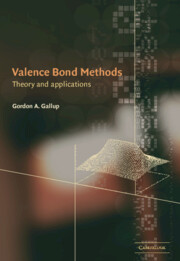Book contents
- Frontmatter
- Contents
- Preface
- List of abbreviations
- I Theory and two-electron systems
- II Examples and interpretations
- 9 Selection of structures and arrangement of bases
- 10 Four simple three-electron systems
- 11 Second row homonuclear diatomics
- 12 Second row heteronuclear diatomics
- 13 Methane, ethane and hybridization
- 14 Rings of hydrogen atoms
- 15 Aromatic compounds
- 16 Interaction of molecular fragments
- References
- Index
15 - Aromatic compounds
Published online by Cambridge University Press: 13 August 2009
- Frontmatter
- Contents
- Preface
- List of abbreviations
- I Theory and two-electron systems
- II Examples and interpretations
- 9 Selection of structures and arrangement of bases
- 10 Four simple three-electron systems
- 11 Second row homonuclear diatomics
- 12 Second row heteronuclear diatomics
- 13 Methane, ethane and hybridization
- 14 Rings of hydrogen atoms
- 15 Aromatic compounds
- 16 Interaction of molecular fragments
- References
- Index
Summary
Benzene is the archetypal aromatic hydrocarbon and its study has been central to the understanding of aromaticity and resonance from the early times. In addition, it has the physical property of having its π electrons reasonably independent from those in σ bonds, leading early quantum mechanics workers to treat the π electrons alone. Since benzene is a ring and the rules for forming Rumer diagrams have one draw noncrossing lines between orbital symbols written in a circle, the Rumer diagrams correspond to the classical Kekulé and Dewar bond schemes that chemists had postulated far earlier than the VB treatments occurred. This parallel has intrigued people since its first observation and led to many discussions concerning its significance. It has also led to considerable work in more qualitative “graphical methods” for which the reader is directed to the literature. (See, inter alia, Randić[59].)
We will examine benzene with different bases and also discuss some of the ideas that consideration of this molecule has led to, such as resonance and resonance energy.
We show again the traditional five covalent Rumer diagrams for six electrons and six orbitals in a singlet coupling and emphasize that the similarity between the ring of orbitals and the shape of the molecule considerably simplifies the understanding of the symmetry for benzene.
- Type
- Chapter
- Information
- Valence Bond MethodsTheory and Applications, pp. 197 - 213Publisher: Cambridge University PressPrint publication year: 2002

